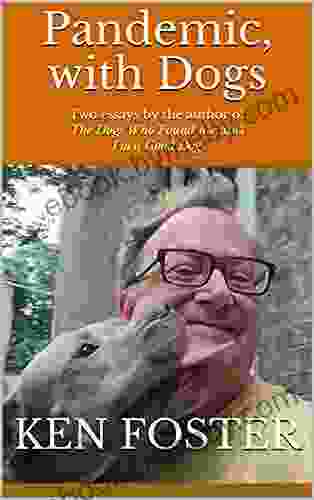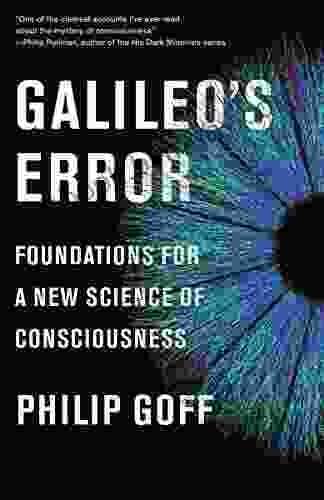Foundations for a New Science of Consciousness: Unraveling the Enigma of the Human Mind

4.5 out of 5
| Language | : | English |
| File size | : | 3586 KB |
| Text-to-Speech | : | Enabled |
| Screen Reader | : | Supported |
| Enhanced typesetting | : | Enabled |
| X-Ray | : | Enabled |
| Word Wise | : | Enabled |
| Print length | : | 238 pages |
: Embarking on a Journey of Discovery
Within the enigmatic tapestry of the human experience, consciousness remains an elusive thread, tantalizingly beckoning us to unravel its intricate mysteries. The conventional paradigms that have sought to define and explain this fundamental aspect of our being have stumbled upon limitations, leaving us yearning for a more profound understanding.
Enter "Foundations for a New Science of Consciousness," a groundbreaking work by renowned cognitive scientist and philosopher Francisco Varela. This seminal book, meticulously crafted over a decade of research and collaboration, boldly challenges the established boundaries of consciousness research and sets forth a transformative framework that promises to revolutionize our comprehension of the human mind.
Chapter 1: The Crisis in Consciousness Science
Varela begins by painting a vivid portrait of the current state of consciousness studies, unveiling its inherent challenges and paradoxes. He meticulously examines the inadequacies of reductionist approaches that attempt to dissect consciousness into isolated fragments, highlighting the need for a holistic understanding that encompasses its dynamic and subjective nature.
Through thought-provoking case studies and real-world examples, Varela exposes the limitations of traditional scientific methods in capturing the multifaceted essence of consciousness. He argues for a paradigm shift, one that embraces the complexity and interdisciplinary nature of this elusive phenomenon.
Chapter 2: The Embodied Mind
Moving beyond the Cartesian dichotomy of mind and body, Varela introduces the groundbreaking theory of embodied cognition. This radical reconceptualization posits that consciousness is fundamentally intertwined with our physical experiences, emotions, and interactions with the environment.
Varela masterfully weaves together evidence from neuroscience, psychology, and even robotics to demonstrate how our bodily experiences profoundly shape our conscious thoughts and perceptions. By rejecting the notion of a disembodied mind, he opens up a new avenue for understanding the nature of human subjectivity.
Chapter 3: The Dynamical Systems Approach
Varela delves into the complexities of dynamical systems theory, a cutting-edge approach that offers a novel way to conceptualize the intricate processes of consciousness. He explains how consciousness can be understood as an emergent property of complex, interconnected neural networks.
Drawing upon examples from natural phenomena such as hurricanes and patterns of brain activity, Varela illustrates how dynamical systems can exhibit self-organization, adaptability, and a capacity for learning and memory. These insights lay the groundwork for a comprehensive theory of consciousness that captures its dynamic and evolving nature.
Chapter 4: The Phenomenological Approach
In contrast to purely scientific perspectives, Varela acknowledges the importance of incorporating subjective experiences into the study of consciousness. He introduces phenomenology, a method of inquiry that focuses on the first-person, qualitative aspects of consciousness.
Through mindful introspection and philosophical exploration, Varela demonstrates how phenomenology can provide valuable insights into the lived experience of consciousness. He argues that by closing the gap between objective and subjective accounts, we can gain a more complete understanding of the full spectrum of human consciousness.
Chapter 5: The Neurophenomenology Approach
Bridging the gap between science and subjectivity, Varela introduces neurophenomenology, an innovative methodology that seamlessly integrates the rigor of scientific investigation with the depth of phenomenological inquiry.
Varela explains how neurophenomenology combines advanced neuroimaging techniques, such as electroencephalography (EEG) and magnetic resonance imaging (MRI),with subjective reports from participants. This hybrid approach allows researchers to explore the neural correlates of conscious experiences while simultaneously capturing their experiential qualities.
Chapter 6: Beyond the Brain
Varela boldly challenges the traditional view that consciousness is solely confined within the boundaries of the brain. Drawing upon evidence from quantum physics, he proposes that consciousness may extend beyond the individual and exist within the wider environment.
Through thought-provoking experiments and theoretical explorations, Varela suggests that consciousness may be a fundamental property of the universe itself. He invites us to envision a cosmos where consciousness is not limited to human beings but permeates all of reality.
: A New Era in Consciousness Research
In the concluding chapter, Varela summarizes the groundbreaking advancements presented in his book and outlines the transformative implications for consciousness research and beyond.
"Foundations for a New Science of Consciousness" is not merely an academic treatise; it is an invitation to rethink the very nature of our existence. Varela challenges us to embrace the richness and complexity of consciousness, acknowledging its subjective, embodied, and possibly even cosmic dimensions.
Through rigorous scientific inquiry, innovative methodologies, and a profound understanding of human experience, Varela has laid the foundations for a new science of consciousness. This groundbreaking work will undoubtedly shape the course of scientific discovery for years to come, inspiring a deeper comprehension of the human mind and our place within the vast tapestry of reality.
4.5 out of 5
| Language | : | English |
| File size | : | 3586 KB |
| Text-to-Speech | : | Enabled |
| Screen Reader | : | Supported |
| Enhanced typesetting | : | Enabled |
| X-Ray | : | Enabled |
| Word Wise | : | Enabled |
| Print length | : | 238 pages |
Do you want to contribute by writing guest posts on this blog?
Please contact us and send us a resume of previous articles that you have written.
 Book
Book Novel
Novel Page
Page Chapter
Chapter Text
Text Story
Story Genre
Genre Reader
Reader Library
Library Paperback
Paperback E-book
E-book Magazine
Magazine Newspaper
Newspaper Paragraph
Paragraph Sentence
Sentence Bookmark
Bookmark Shelf
Shelf Glossary
Glossary Bibliography
Bibliography Foreword
Foreword Preface
Preface Synopsis
Synopsis Annotation
Annotation Footnote
Footnote Manuscript
Manuscript Scroll
Scroll Codex
Codex Tome
Tome Bestseller
Bestseller Classics
Classics Library card
Library card Narrative
Narrative Biography
Biography Autobiography
Autobiography Memoir
Memoir Reference
Reference Encyclopedia
Encyclopedia Karen Anne Golden
Karen Anne Golden Phil Pustejovsky
Phil Pustejovsky Matt Morris
Matt Morris Julie S Snyder
Julie S Snyder Kay Wills Wyma
Kay Wills Wyma Kemp Powers
Kemp Powers Miriam Manela
Miriam Manela K W Tey
K W Tey Keisha Quallo
Keisha Quallo Stuart D Paine
Stuart D Paine Rebecca Vorkapich
Rebecca Vorkapich Suzy Kline
Suzy Kline Martina Lauchengco
Martina Lauchengco Katherine Tarbox
Katherine Tarbox Steve Portigal
Steve Portigal Keira Gillett
Keira Gillett Katie J Newman
Katie J Newman Katy Duffield
Katy Duffield Kelsey Oseid
Kelsey Oseid T Berry Brazelton
T Berry Brazelton
Light bulbAdvertise smarter! Our strategic ad space ensures maximum exposure. Reserve your spot today!

 Darrell PowellUnveiling the Dark Depths: A Journey into 'Cruelty: The Human Heart' by Neil...
Darrell PowellUnveiling the Dark Depths: A Journey into 'Cruelty: The Human Heart' by Neil...
 Jorge Luis BorgesUnleash Your Toddler's Language Potential: A Comprehensive Guide to Teaching...
Jorge Luis BorgesUnleash Your Toddler's Language Potential: A Comprehensive Guide to Teaching...
 Kazuo IshiguroEscape into a World of Enchanting Fairy Tales: Reimagine the Magic of Snow...
Kazuo IshiguroEscape into a World of Enchanting Fairy Tales: Reimagine the Magic of Snow... Brayden ReedFollow ·18.7k
Brayden ReedFollow ·18.7k Lee SimmonsFollow ·19.9k
Lee SimmonsFollow ·19.9k Jason ReedFollow ·10.4k
Jason ReedFollow ·10.4k Robert HeinleinFollow ·15.4k
Robert HeinleinFollow ·15.4k Javier BellFollow ·6k
Javier BellFollow ·6k Cody RussellFollow ·17.2k
Cody RussellFollow ·17.2k Isaiah PowellFollow ·4.9k
Isaiah PowellFollow ·4.9k Aaron BrooksFollow ·13.1k
Aaron BrooksFollow ·13.1k

 George Orwell
George OrwellPandemic with Dogs: Two Essays
By Susannah Charleson In the midst of...

 Leo Mitchell
Leo MitchellAdam Smith's The Wealth of Nations: A Classic Treatise on...
Adam Smith's The...

 Cade Simmons
Cade SimmonsUnlock Your Communication Potential: Effective Techniques...
Communication is a fundamental...

 Floyd Richardson
Floyd RichardsonFire and Ashes: Success and Failure in Politics
Fire and Ashes: Success and...

 Oliver Foster
Oliver FosterUnlock the Enchanting Mystery of Ken Follett's "The Key...
Embark on a captivating literary journey into...
4.5 out of 5
| Language | : | English |
| File size | : | 3586 KB |
| Text-to-Speech | : | Enabled |
| Screen Reader | : | Supported |
| Enhanced typesetting | : | Enabled |
| X-Ray | : | Enabled |
| Word Wise | : | Enabled |
| Print length | : | 238 pages |








